NCERT Solutions for Class-11 Maths Chapter-9 Sequences and Series
NCERT Solutions For Class 11 Maths
Chapter-9 Sequences and Series Exercise 9.3 prepared by the expert of Physics Wallah score more with Physics Wallah NCERT Class 11 maths solutions. You can download solution of all chapters from Physics Wallah
NCERT solutions
of class 11.
NCERT Solutions for Class-11 Maths Exercise 9.3
Question
1. Find the 20
th
and n
th
terms of the G.P. 5/2,5/4,5/8
Solution :
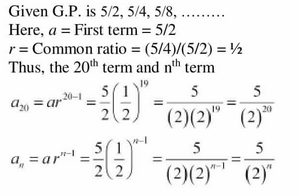
Question
2. Find the 12
th
term of a G.P. whose 8
th
term is 192 and the common ratio if 2.
given
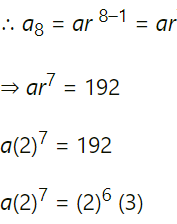
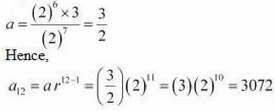
Solution :
given common ratio of G.P r = 2; Let a be the first term of G.P
Question 3. The 5 th ,8 th and 11 th terms of a G.P. are p, q and s, respectively. Show that q 2 =ps.
Solution :
Let a be the first term and r be the comman ratio of G.P according to given condition

Dividing Equation (2) by (1) We obtained
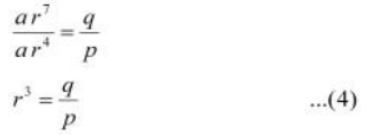
Dividing Equation (3) by (2) We obtained
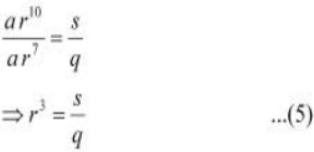
Equating the equation
 obtained in (4) and (5) we obtain
obtained in (4) and (5) we obtain

Thus given result is proved
Question
4. The 4
th
term of a G.P. is square of its second term and the first term is -3. Determine its 7
th
term.
Solution :
Let
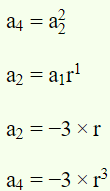
Acording to the Question
Question
5. Which term of the following sequences:
(a) 2 ,2√2,4,… is 128?
(b) √3, 3, 3√3,….is 729?
(c) 1/3, 1/9, 1/27,… is 1/19683?
Solution :
Therefore, 13
th
term of the given G.P. is 128.
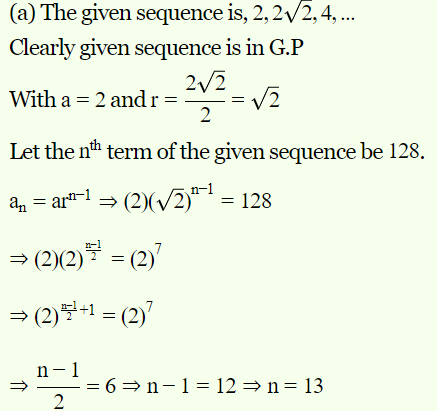
Therefore, 12
th
term of the given G.P. is 729.
Question
6. For what values of x, the numbers −2/7,x,−7/2a are in G.P.?
Solution :
Given:
 are in G.P.
are in G.P.
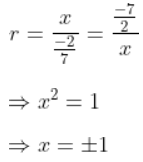
Thus, for
 given noumbers will be i Gp
given noumbers will be i Gp
Find the sum to indicated number of terms in each of the geometric progression in Exercises 7 to 10:
Question
7. 0.15, 0.015, 0.0015, ………. 20 terms
Solution :
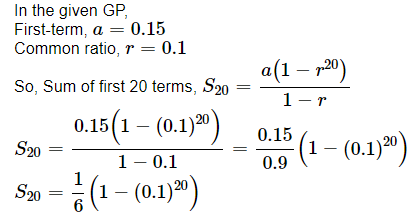
Question
8. √7,
√21, 3√7,…,n terms
Solution :
Here
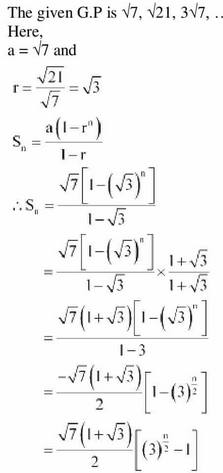
Question
9. Find the sum to n terms in the geometric progression 1,−a, a
2
, −a
3
… ( if a≠ −1)
Solution :
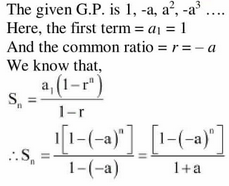
Question
10. Find the sum to n terms in the geometric progression x
3
, x
5
,x
7
,…n terms (if x≠±1)
Solution :
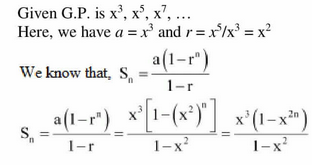
Question
11. Evaluate:

Solution :
Given:

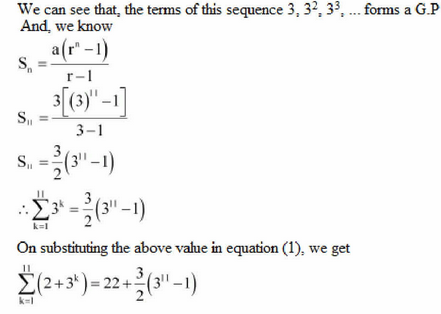
Question
12. The sum of first three terms of a G.P. is 39/10 and their product is 1. Find the common ratio and the terms.
Solution :
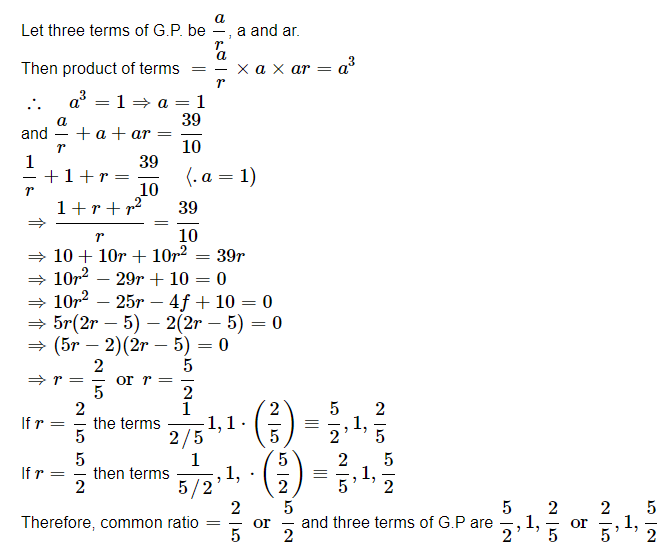
Question
13. How many terms of G.P. 3,3
2
,3
3
,… are needed to give the sum 120?
Solution :
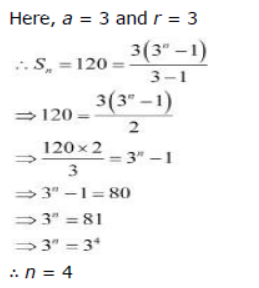
Question
14. The sum of first three terms of a G.P. is 16 and the sum of the next three terms is 128.
Determine the first term, the common ratio and the sum to n terms of the G.P.
Solution :
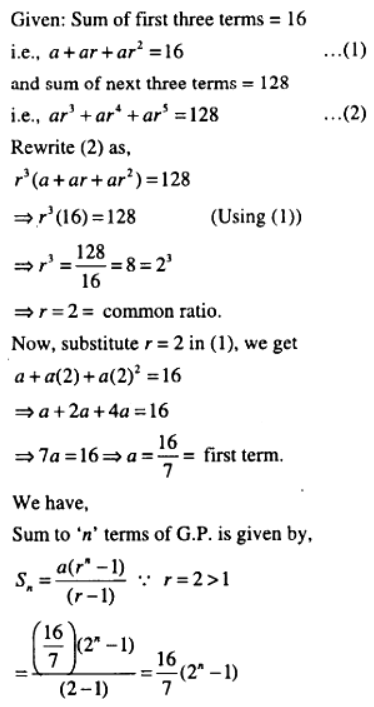
Question
15. Given a G.P. with a= 729 and 7
th
term 64, determine S
7;
Solution :
Given: a = 729 and a
7
=64
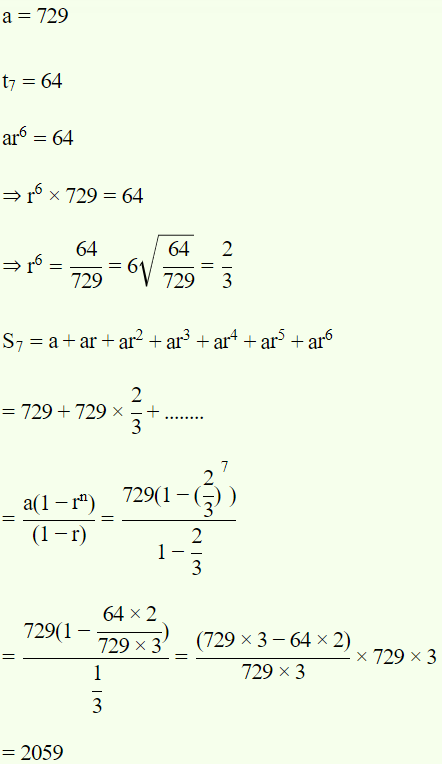
Question
16. Find a G.P. for which sum of the first two terms is -4 and the fifth term is 4 times the third term.
Solution :
Given:

Question
17. If the 4
th
,10
th
and16
th
terms of a G.P. are x, y and z, respectively.
Prove that x, y, z are in G.P.
Solution :
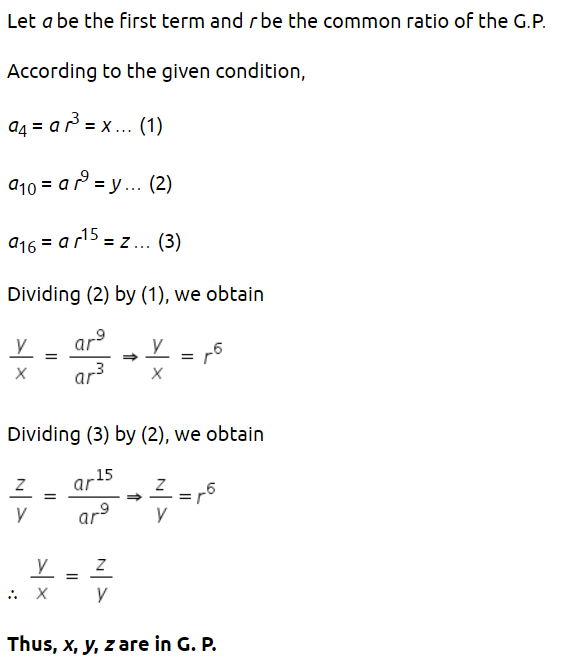
Question
18. Find the sum to n terms of the sequences 8, 88, 888, 8888, ……
Solution :
Here
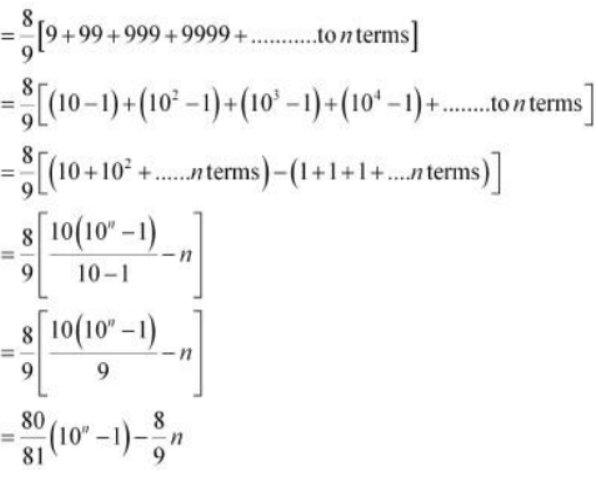
Question
19. Find the sum of the product of the corresponding terms of the sequences 2, 4, 16, 32 and 128, 32, 8, 2, 1/2.
Solution :
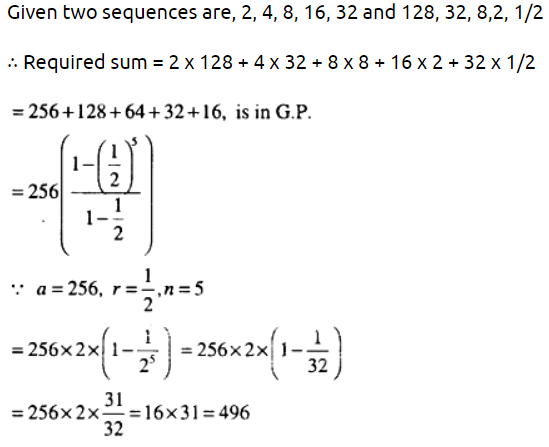
Question
20. Show that the products of the corresponding terms of the sequences a, ar, ar
2
…ar
n−1
and A,AR, AR
2
,…AR
n−1
form a G.P, and find the common ratio.
Solution :
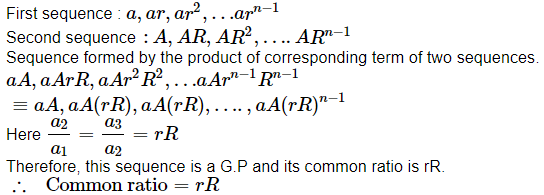
Question
21. Find four numbers forming a geometric progression in which the third term is greater than the first term by 9 and the second term is greater than by 4
th
by 18.
Solution :
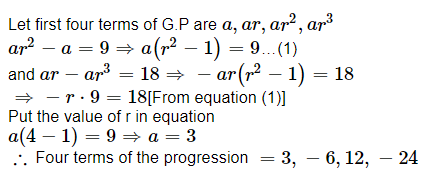
Question
22. If the p
th
,q
th
and r
th
terms of a G.P. are a, b and c, respectively. Prove that a
q−r
b
r−p
c
P−q
=1
Solution :

Question
23. If the first and the nth term of a G.P. are a and b, respectively, and if P is the product of n terms, prove that P
2
= (ab)
n
.
Solution :
The first term of the G.P is a and the last term is b.
Therefore, the G.P. is a,ar,ar 2 ,ar 3 .....ar n-1 , where r is the common ratio.
b = ar n-1 ....(1)
P = Product of n terms
= (a) (ar) (ar 2 ) (ar 3 ).....(ar n-1 )
=(a x a x....a)(r x r² x.....r n-1 )
= a n r 1 + 2 +(n-1) ...(2)
Here, 1, 2, …(n-1) is an A.P.

Hence, proved
Question
24. Show that the ratio of the sum of first n terms of a G.P. to the sum of terms from (n+1)
th
to (2n)
th
term is 1/ rn
Solution :
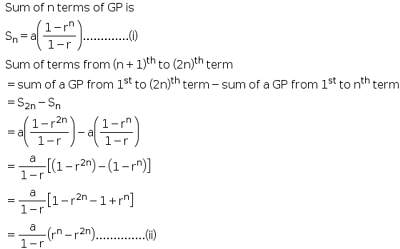
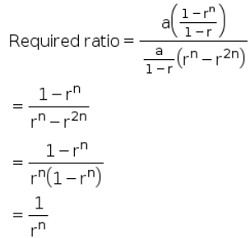
Question
25. If a, b, c and d are in G.P. show that (a
2
+ b
2
+ c
2
) (b
2
+ c
2
+ d
2
) = (ab + bc + cd)
2
Solution :
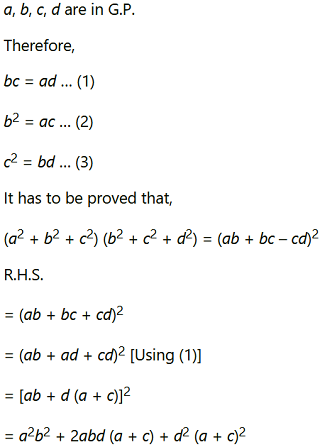
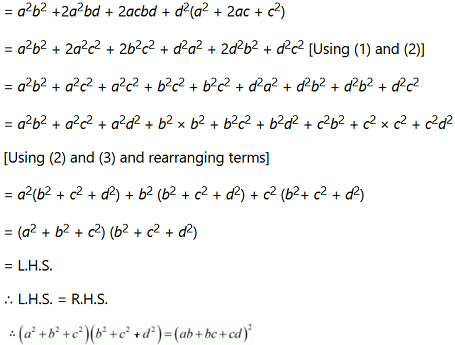
Therefore, L.H.S. = R.H.S.
Question
26. Insert two numbers between 3 and 81 so that the resulting sequence us G.P.
Solution :
Let G
1
and G
2
be two numbers between 3 and 81 such that 3,G
1
,G
2,
81
are in G.P.
Let a be the first term and r be the common ratio of the G.P.
∴81 = (3)(r)
3
⇒ r³ = 27
⇒ r = 3 (Taking real roots only)
For r = 3,
G 1 = ar = (3)(3) = 9
G1 = ar 2 = (3)(3) 2 = 27
Thus, the required two numbers are 9 and 27
Question
27. Find the value of n so that
 may be the geometric mean between a and b.
may be the geometric mean between a and b.
Solution :
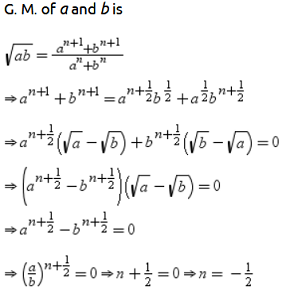
Question
28. The sum of two numbers is 6 times their geometric mean, show that numbers are in the ratio ((3+2√2) : (3−2√2)
Solution :
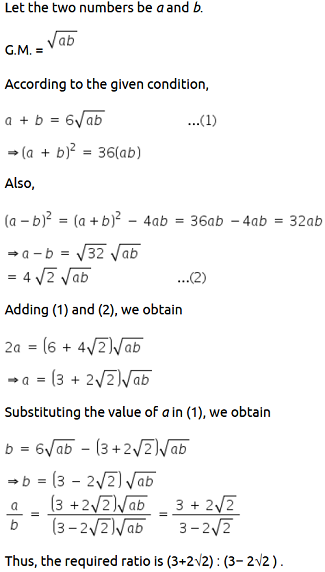
Question
29. If A and G be A.M. and G.M. respectively between two positive numbers, prove that the numbers are

Solution :
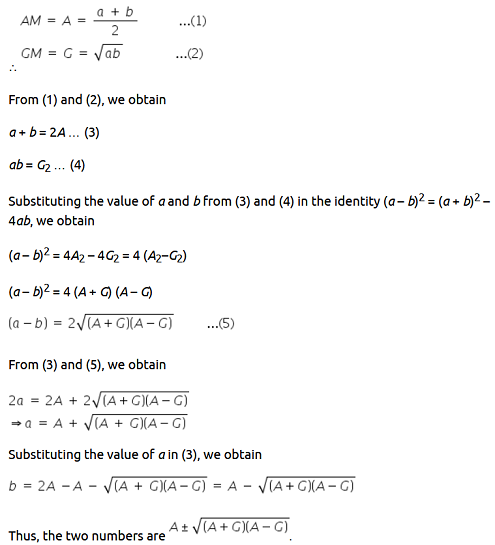
Question 30. The number of bacteria in a certain culture doubles every hour. If there were 30 bacteria present in the culture originally, how many bacteria will be present at the end of 2 nd hour, 4 th hour and nth hour?
Solution :
Bacteria present in the culture originally = 30
Since the bacteria doubles itself after each hour, then the sequence of bacteria after each hour is a G.P.
Here a = 30 and r = 2
∴ a3 = ar² = (30)(2)² =120
Therefore, the number of bacteria at the end of 2nd hour will be 120
a5 = ar 4 = (30)(2) 4 = 480
a n+1 = ar n = (30) 2 n
Thus, number of bacteria at the end of nth hour will be (30) 2 n
Question
31. What will Rs. 500 amount to 10 years after its deposit in a bank which pays annual interest rate of 10% compounded annually?
Solution :
The amount deposited in the bank is Rs 500.
At the end of first year, amount = Rs 500(1 + 1/10)= Rs 500 (1.1)
At the end of 2nd year, amount = Rs 500 (1.1) (1.1)
At the end of 3rd year, amount = Rs 500 (1.1) (1.1) (1.1) and so on
∴Amount at the end of 10 years = Rs 500 (1.1) (1.1) … (10 times)
= Rs 500(1.1) 10
Question
32. If A.M. and G.M. of roots of a quadratic equation are 8 and 5 respectively then obtain the quadratic equation.
Solution :
Let a and b be the roots of required quadratic equation.
Then A.M. = a+b/2 = 8 ⇒ a+b = 16 ....(1)
And G.M. = √ab = 5 ⇒ 25 .......(2)
Now, Quadratic equation is given by,
x 2 - x (Sum of roots) + (Product of roots) = 0
x 2 - x (a+b) + (ab) = 0
x 2 - 16x + 25 = 0 [Using (1) and (2)]
Thus, the required quadratic equation is x
2
- 16x + 25 = 0.
